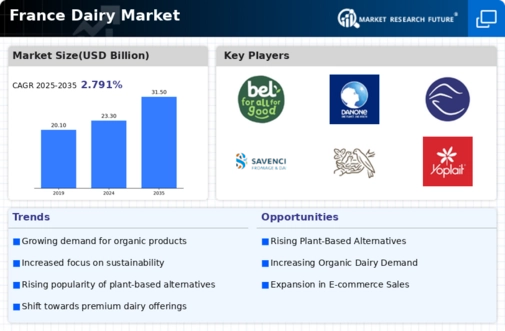Sustainability Initiatives
Sustainability has emerged as a crucial factor influencing the dairy market in France. Consumers are increasingly concerned about the environmental impact of their food choices, leading to a demand for sustainably produced dairy products. This trend is evident in the rise of organic dairy farming practices, which have seen a growth rate of approximately 15% annually. Furthermore, initiatives aimed at reducing carbon footprints and improving animal welfare are becoming more prevalent among dairy producers. In 2025, it is estimated that around 25% of dairy products sold in France will be certified organic or sustainably sourced. This shift towards sustainability not only meets consumer expectations but also positions companies favorably in a competitive market, as they align with broader environmental goals.
Evolving Consumer Preferences
The dairy market in France is experiencing a notable transformation in consumer preferences, particularly among younger demographics. Millennials and Generation Z are increasingly favoring products that are not only convenient but also align with their lifestyle choices. This demographic shift is driving the demand for ready-to-drink dairy beverages and snackable dairy products. In 2025, it is projected that the ready-to-drink segment will capture approximately 20% of the dairy market. Additionally, flavor innovation is becoming a key focus, with consumers seeking unique and exotic flavors in dairy products. This evolution in consumer preferences is prompting manufacturers to diversify their product lines and explore new marketing strategies to engage these younger consumers effectively.
Increasing Health Consciousness
The growing awareness of health and nutrition among consumers appears to be a pivotal driver for the dairy market in France. As individuals become more health-conscious, they tend to seek products that align with their dietary preferences. This trend is reflected in the rising demand for low-fat and fortified dairy products, which are perceived as healthier options. In 2025, the market for low-fat dairy products is projected to account for approximately 30% of total dairy sales in France. Additionally, the popularity of probiotic yogurts and functional dairy beverages is on the rise, indicating a shift towards products that offer health benefits. This increasing health consciousness is likely to shape the product offerings within the dairy market, compelling manufacturers to innovate and adapt to consumer preferences.
Regulatory Changes and Standards
Regulatory changes and standards are increasingly influencing the dairy market in France. The government has implemented stricter regulations regarding food safety, labeling, and animal welfare, which are reshaping industry practices. Compliance with these regulations is essential for dairy producers to maintain market access and consumer trust. In 2025, it is expected that adherence to these standards will become even more critical, as consumers demand transparency and accountability from food producers. This regulatory landscape may pose challenges for smaller producers, but it also presents opportunities for those who can adapt and innovate. As a result, the dairy market is likely to see a consolidation of players who can meet these evolving standards while ensuring product quality and safety.
Technological Advancements in Production
Technological advancements are playing a significant role in shaping the dairy market in France. Innovations in production processes, such as automation and precision farming, are enhancing efficiency and productivity within the industry. These advancements not only reduce operational costs but also improve product quality and safety. For instance, the implementation of advanced milking technologies has led to increased milk yields and better animal health. In 2025, it is anticipated that the adoption of such technologies will contribute to a 10% increase in overall dairy production in France. Furthermore, the integration of data analytics in supply chain management is optimizing distribution and reducing waste, thereby benefiting both producers and consumers in the dairy market.



















Leave a Comment